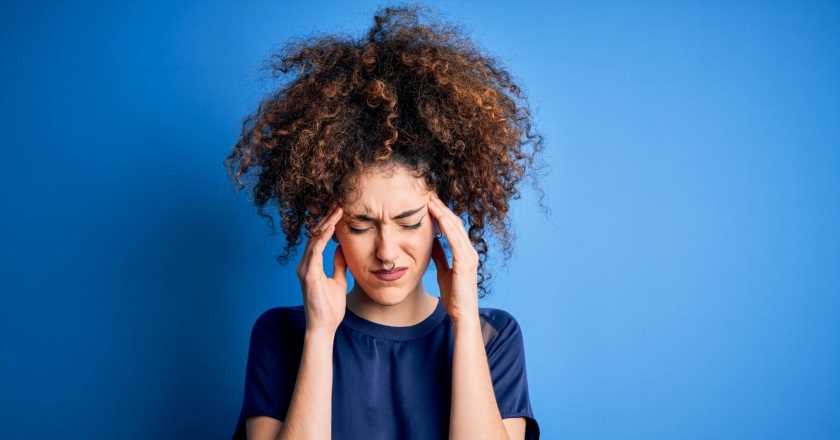Migraine is the third most common ailment in the world, but it disproportionately affects women. Why? Well, it’s linked to our menstrual cycle, of course…
It was a rainy September afternoon, and I was at the park with my daughter when my left eye started to ache. My heart sank and my anxiety surged: I knew I was about to get a migraine. Sure enough, by teatime, the whole left side of my head was throbbing and I ended up in bed for three days straight. Paracetamol didn’t even touch the sides of the pain, so I just had to ride it out.
My relationship with migraines is a long one: I suffered my first visual migraine at the age of 18, and since then I have been prone to debilitating, three-day headaches accompanied by nausea and sensitivity to light and sound.
The migraines tend to range in severity and type, and not to be dramatic, but shortly after having my first child, I experienced a visual migraine so severe that I totally lost the vision in one eye. Sobbing, I asked my husband to take good care of our daughter, as I was convinced I was about to die.
A speedy trip to the opticians put my mind at rest (I almost jumped up and hugged her), but I still dread the familiar warning signs. And I’m in good company: according to charity The Migraine Trust, migraines affect three times as many women as men, and what’s more, women’s symptoms are likely to be more severe and longer lasting.
You may also like
This is the reality of just how debilitating migraines can be
Why are female migraines so bad?
So, what’s the deal? While there are a variety of migraine triggers, from dehydration to poor sleep quality, it won’t surprise you to hear that those pesky hormones are largely responsible.
Nutritional therapist Thalia Pellegrini has suffered from severe migraines since her periods began at the age of 12, and explains: “Hormonal shifts are a key trigger for many women who struggle with migraines. More than half of these women notice a link with their period, with 70% of female migraine sufferers reporting a worsening of symptoms just before or during their period.”
So-called “menstrual migraines” are thought to be caused by the natural drop in oestrogen levels towards the end of your menstrual cycle, immediately before your period starts. In addition, people who suffer from heavy and painful periods have higher levels of the hormone prostaglandin, which can also contribute to menstrual migraines, so it’s a double whammy for us lucky ones.
Heavy periods can also cause iron deficiency, which can also contribute to any migraines that take place around your period.

The impact of hormonal migraines on sufferers is huge. Pellegrini says: “My migraines are 100% hormonal. I used to get them mid-cycle around ovulation, but now I’m perimenopausal they’re more unpredictable. The only time I haven’t suffered was in the later stages of both my pregnancies, but during my first trimesters, I had one every 10 days like clockwork.”
So, how can you tell if your migraines are hormonal? Experts recommend keeping a diary for at least three months to monitor when you suffer symptoms alongside the day your period begins. To be diagnosed as menstrual, your migraines will typically occur between two days before and up to three days into your period, in at least two out of three consecutive months.
The bad news is, according to a study published in the journal Headache, menstrual migraines tend to not only be more severe than a ‘normal’ migraine, but they last longer and are less responsive to treatment, as 45-year-old yoga instructor Maria Jones knows only too well: “Typically, I would get either a migraine or a cluster headache each month, lasting around three days with two or three days of fatigue and exhaustion afterwards. I couldn’t keep pain medication down due to the vomiting, so my GP would sometimes have to come to my home to administer an IV for pain relief. It was hell.”
It was only when Jones decided to try oestrogen patches in March this year that she realised her migraines were purely hormonal: “I spent years thinking it was stress or dehydration. I even had an MRI to see if I had clots on my brain, but since I started on oestrogen, I haven’t had a single headache.”
Let’s be clear: this is a big deal for women. In addition to coping with periods, it’s pretty much impossible for any of us to just down tools for three days each month to recover from a migraine, and it’s important to note that women who struggle with menstrual migraines are also likely to suffer attacks at other times of the month too.
Like Jones, women often aren’t recognising that their headaches are menstrual migraines, and according to the National Migraine Centre this “under-recognition” leads to doctors under-diagnosing migraines.
You may also like
Can exercise help relieve migraines? How to train if you're prone to the condition
Having said this, once you know you’re dealing with a menstrual migraine pattern, there are ways you can manage your symptoms, so it is important to see your GP to discuss your options. Your contraceptive choices are impacted as it’s not considered safe for migraine suffers to take the combined pill, but I’ve found that the hormonal coil (Mirena intrauterine system) has been great in terms of managing both my periods (goodbye, monthly cramps) and my migraines.
As is so often the case, it’s advisable to reduce your alcohol intake, get plenty of sleep and eat well and often. If that’s not an excuse for pizza and Netflix in bed, I don’t know what is.
For more help and support, check out The Migraine Trust and The National Migraine Centre for free resources.
Images: Getty
Source: Read Full Article
